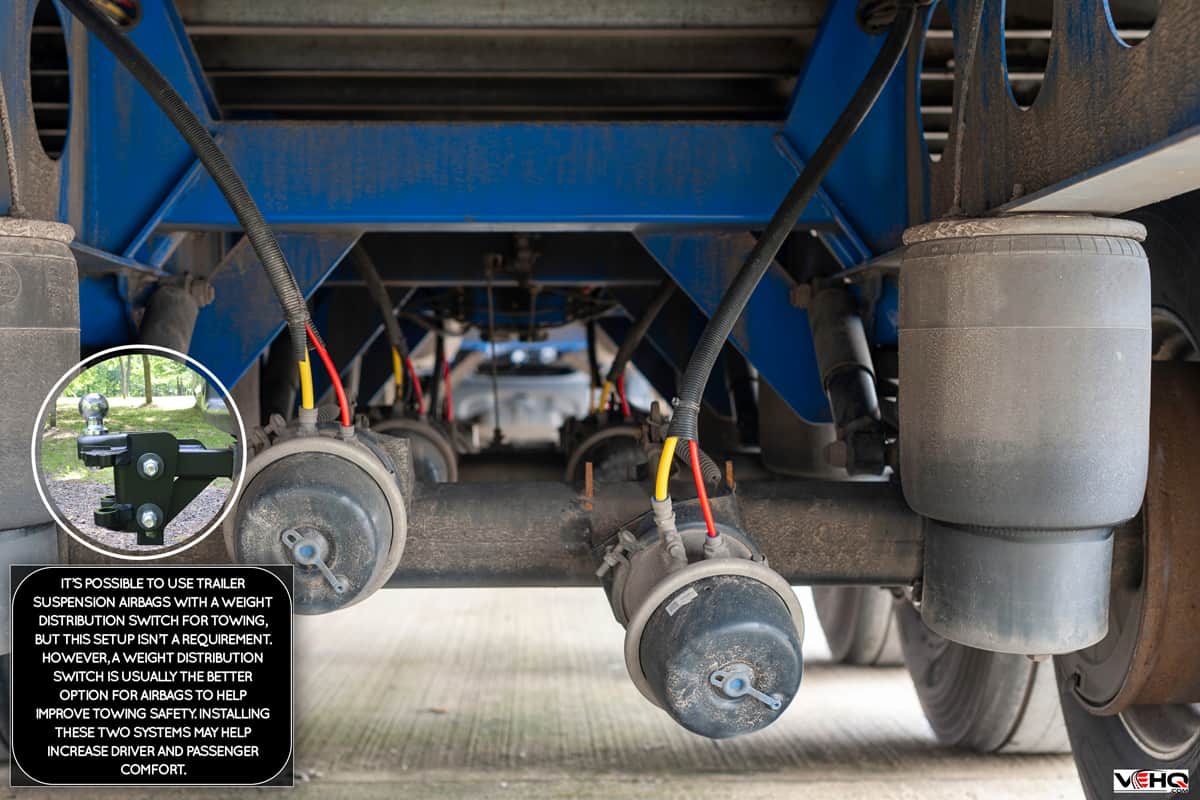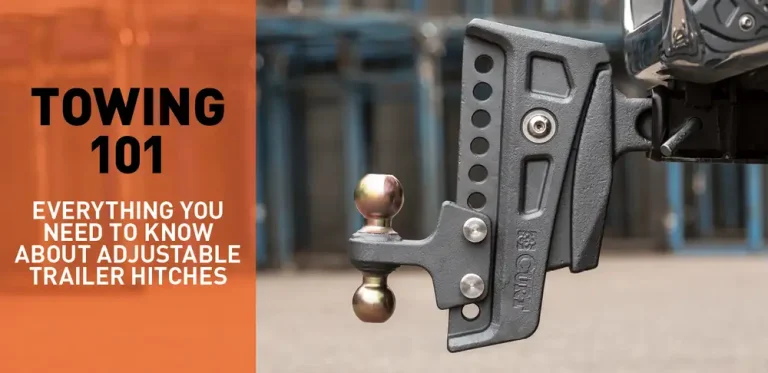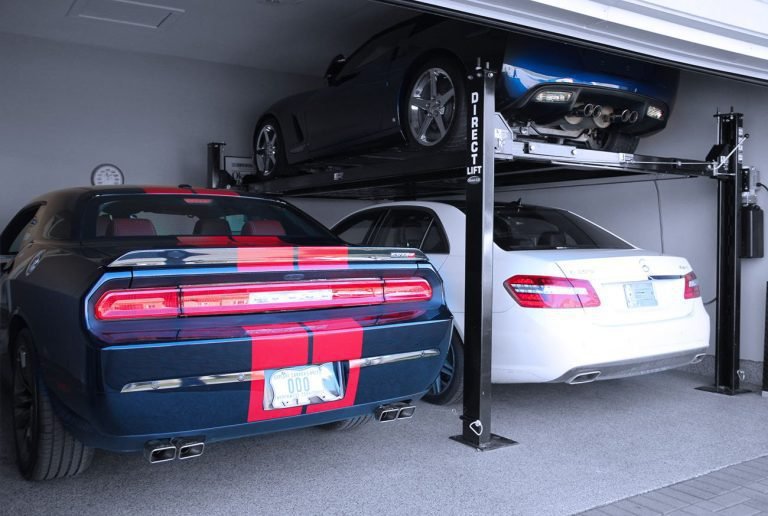Yes, a weight distribution hitch is still needed even if you have air bags installed. Having air bags does not eliminate the need for a weight distribution hitch when towing a trailer.
While air bags can help with leveling and provide additional support, a weight distribution hitch is designed to distribute the weight evenly between the trailer and the tow vehicle’s axles, improving stability and control. By using both air bags and a weight distribution hitch, you can achieve optimal towing performance and safety.

Credit: vehq.com
How Weight Distribution Hitches Work
Weight distribution hitches and air bags serve different purposes when it comes to towing. While air bags primarily help with leveling the vehicle and improving ride quality, a weight distribution hitch is essential for distributing the weight evenly, enhancing stability, and preventing sway during towing.
So, if you have air bags, you may still need a weight distribution hitch for safer towing.
Overview Of Weight Distribution Hitches
- Weight distribution hitches are essential for safe towing, especially when you have a heavy trailer or a large load. They evenly distribute the weight between the trailer and the tow vehicle, ensuring better stability and control on the road.
- These hitches work by transferring some of the tongue weight, or the downward force exerted on the hitch ball, to the front axle of the tow vehicle and the axles of the trailer.
- By distributing the weight evenly, weight distribution hitches can prevent the front of the tow vehicle from being lifted, which could affect steering, braking, and overall handling.
Importance Of Weight Distribution For Safe Towing
- Maintaining proper weight distribution is crucial for safe towing. It helps in preventing swaying or fishtailing of the trailer, enhances braking performance, and improves overall control and stability.
- When the weight is not properly distributed, the tail end of the trailer can become heavy, causing the front of the tow vehicle to rise. This imbalance affects the traction and steering of the tow vehicle, making it difficult to maneuver on the road.
- Without a weight distribution hitch, excessive weight on the rear of the tow vehicle can lead to reduced tire grip, increased stopping distance, and a higher risk of accidents.
Explanation Of Weight Distribution Hitch Components
A weight distribution hitch consists of several components working in tandem to ensure safe towing:
- Receiver: This is the part that connects the hitch to the tow vehicle. It is mounted to the vehicle’s frame or rear bumper and provides a secure attachment point for the weight distribution hitch.
- Ball mount: The ball mount holds the hitch ball, which connects to the coupler on the trailer. It serves as the pivot point between the tow vehicle and the trailer.
- Spring bars: These adjustable bars are the heart of the weight distribution hitch. They connect to the receiver and the trailer’s frame, distributing the weight from the tongue of the trailer to both the tow vehicle and the trailer’s axles.
- Sway control: Some weight distribution hitches also include sway control mechanisms to minimize side-to-side movement or swaying of the trailer. This ensures better stability, especially in windy conditions or when passing large vehicles.
- Safety chains: Safety chains serve as a backup connection between the tow vehicle and the trailer. In the event of a hitch failure, they help to keep the trailer attached to the tow vehicle and minimize potential damage or accidents.
Weight distribution hitches are necessary for safe towing, even if you have air bags. They effectively distribute the weight between the tow vehicle and the trailer, ensuring improved control, stability, and braking performance. By understanding the components of a weight distribution hitch and their role in maintaining proper weight distribution, you can make informed decisions for a safe towing experience.
So, whether you’re towing a camper, boat, or heavy cargo, investing in a weight distribution hitch is a wise choice.
Role Of Air Bags In Towing
Air bags play a crucial role in towing by helping to maintain the stability and levelness of the vehicle. However, despite the benefits of air bags, a weight distribution hitch is still recommended for additional towing safety and control.
What Are Air Bags And How Do They Work?
- Air bags are a suspension enhancement system designed to assist in maintaining a level ride height when towing heavy loads.
- Unlike traditional suspension systems, air bags can be adjusted and inflated to accommodate the weight of the load being towed.
- They are typically installed between the tow vehicle’s chassis and the rear axle, providing additional support and stability.
Benefits Of Using Air Bags For Towing:
- Improved stability: Air bags help distribute the weight of the load evenly over the rear axle, reducing sagging and improving handling and control while towing.
- Level ride height: By adjusting the air pressure in the bags, you can maintain a level ride height, ensuring better alignment of the tow vehicle and trailer.
- Enhanced braking: Air bags can improve braking performance by minimizing the tendency of the rear end to sag, providing better weight distribution and reducing the risk of trailer sway.
- Reduced wear and tear: By minimizing sagging and improving weight distribution, air bags can help minimize stress on the tow vehicle’s suspension, tires, and other components, prolonging their lifespan.
Addressing Misconceptions About Air Bags And Weight Distribution Hitches:
- Air bags as a standalone solution: While air bags can provide additional support when towing, they should not be considered a replacement for a weight distribution hitch. Air bags alone may not effectively distribute weight or control sway, especially with heavier loads.
- Complementary role: Air bags can work in conjunction with a weight distribution hitch, providing additional support and stability. The weight distribution hitch helps evenly distribute the load between the tow vehicle and the trailer’s axles, reducing stress on the tow vehicle’s rear suspension and promoting a level ride height.
- Proper setup: It is essential to install air bags correctly and adjust the air pressure based on the load being towed. Consult the manufacturer’s instructions or seek professional advice to ensure proper setup and maximize their effectiveness.
- Customization: Air bags offer the benefit of adjustability, allowing you to fine-tune the suspension to suit different towing scenarios. However, it’s crucial to remember that they work best when used in conjunction with an appropriate weight distribution hitch.
In Summary:
Air bags play a crucial role in improving stability, maintaining a level ride height, enhancing braking, and reducing wear and tear when towing heavy loads. While they offer valuable support, they should be seen as a complementary system to weight distribution hitches rather than a standalone solution.
Both air bags and weight distribution hitches work hand in hand to provide optimal towing performance and safety. Proper installation and adjustment are key to unlocking their full potential.
Comparing The Functions Of Weight Distribution Hitches And Air Bags
Comparing the functions of weight distribution hitches and air bags is crucial to determine if you need both. While air bags help with leveling the vehicle, weight distribution hitches ensure proper weight distribution and control sway. Assessing your specific towing needs will help you make an informed decision.
Key Differences Between Weight Distribution Hitches And Air Bags:
- Weight distribution hitches:
- Distribute the weight of the towed load evenly across both the trailer and the towing vehicle, which helps maintain stability and balance.
- Utilize spring bars and a hitch head to redistribute the weight, ensuring that the trailer does not put excessive pressure on the rear axle of the towing vehicle.
- Benefit larger trailers or those with heavy tongue weights, as they can improve handling and control.
- Can be adjusted to suit different loads and towing conditions.
- Can help reduce sway and improve braking performance.
- Air bags:
- Are installed in the rear suspension of the towing vehicle to provide additional support and stability.
- Help level the vehicle and prevent sagging when carrying heavy loads, especially in the rear.
- Help improve overall ride quality by reducing bouncing and vibrations.
- Can be adjusted to increase or decrease the amount of air pressure, depending on the load being carried.
- Are generally more suitable for smaller trailers or those with lighter tongue weights.
Pros And Cons Of Using A Weight Distribution Hitch:
Pros:
- Improved stability and control of the towing vehicle and trailer.
- Better weight distribution, reducing the strain on the rear axle and ensuring even tire wear.
- Reduced sway, making the towing experience safer and more comfortable.
- Enhanced braking performance and more responsive steering.
- Adjustable to accommodate different loads and towing conditions.
Cons:
- Additional installation and setup time required.
- Can add extra weight to the towing vehicle.
- May require periodic maintenance and adjustments.
Pros And Cons Of Using Air Bags:
Pros:
- Helps maintain a level ride height and prevent sagging.
- Reduces bouncing and vibrations for a smoother towing experience.
- Can be adjusted to support different load weights.
- Easy installation and minimal maintenance.
Cons:
- Does not address weight distribution issues as effectively as a weight distribution hitch.
- May not provide the same level of stability and control.
- Limited to providing rear support only.
Understanding When To Use Each Option:
- Use a weight distribution hitch when:
- Towing larger trailers or those with heavy tongue weights.
- Stability and control are top priorities.
- Better weight distribution is needed.
- Improved braking and steering performance are desired.
- Use air bags when:
- Carrying heavy loads that cause rear sagging.
- Smoother ride quality is desired.
- Rear support is the main concern rather than weight distribution.
- Towing smaller trailers with lighter tongue weights.
Factors To Consider Before Choosing A Towing Solution
Before choosing a towing solution, it’s important to evaluate if you need a weight distribution hitch when using air bags. This consideration is crucial to ensure safe and optimal towing performance.
When planning to tow a trailer, it is crucial to choose the right towing solution for maximum safety and stability on the road. While air bags can provide additional support to your towing vehicle, it is important to understand the various factors that come into play before deciding if a weight distribution hitch is still necessary.
Consider the following aspects to make an informed decision:
Weight Of The Trailer Compared To The Towing Vehicle:
- Ensure that the weight of the trailer does not exceed the towing capacity of your vehicle. Excessive weight can strain the suspension system and compromise stability.
- If the trailer is significantly heavier than the towing vehicle, a weight distribution hitch may still be necessary to properly distribute the weight and prevent rear-end sagging.
Tongue Weight And Its Impact On Stability:
- Tongue weight refers to the downward force applied by the trailer on the hitch. It helps maintain stability during towing.
- If the tongue weight exceeds the recommended limit for your towing vehicle, it can negatively affect handling and control, even with the presence of air bags.
- A weight distribution hitch can redistribute the tongue weight more evenly across the axles of the towing vehicle, enhancing stability and control.
Suspension Characteristics Of The Towing Vehicle:
- Consider the type of suspension your towing vehicle has. Air bags can provide additional support, but the suspension system’s design and capabilities should also be taken into account.
- If your vehicle’s suspension is not specifically designed for towing heavy loads, a weight distribution hitch can help minimize stress on the suspension components and improve overall safety.
Understanding The Limitations Of Air Bags:
- While air bags can improve the levelness of your towing vehicle, they have limitations in terms of providing weight distribution and sway control.
- Air bags primarily focus on load leveling, whereas weight distribution hitches are designed to evenly distribute the weight between the vehicle and trailer axles, enhancing stability and control.
- Air bags may not be sufficient for heavier trailers or when towing in challenging road and weather conditions.
Considering these factors will help you assess whether air bags alone are enough for your towing needs or if investing in a weight distribution hitch is necessary for optimum safety and stability. It’s important to prioritize safety and choose the right towing solution based on the specific characteristics of your towing vehicle and trailer.
Assessing The Performance Of Air Bags Alone
Assessing the performance of air bags alone is essential to determine if a weight distribution hitch is necessary. While air bags provide additional support for heavy loads, it’s important to evaluate their effectiveness based on individual towing needs. (43 words)
Evaluating The Effect Of Air Bags On Weight Distribution
When it comes to towing a trailer, weight distribution is a crucial factor that should not be overlooked. Air bags are commonly used to enhance the ride quality of vehicles that tow heavy loads. These air suspension systems may give drivers a false sense of security when it comes to weight distribution, leading them to question whether a weight distribution hitch is still necessary.
Let’s delve into the performance of air bags alone and whether they are sufficient in achieving proper weight distribution.
- Air bags are designed to support the weight of the load being towed by providing additional support to the rear suspension of the vehicle. This helps to level the vehicle and improve stability during towing.
- By leveling the vehicle, air bags can potentially distribute the weight more evenly between the front and rear axles, which can result in improved handling and control.
- Air bags can also help reduce the sagging of the rear end of the vehicle when a heavy load is present, which can help with visibility and maintain proper headlight alignment.
Identifying Potential Issues With Relying Solely On Air Bags
While air bags can be beneficial in various ways, relying solely on them for weight distribution can present some potential issues. It’s essential to consider the following points:
- Air bags primarily focus on supporting the rear suspension, but they do not actively redistribute weight from the rear axle to the front axle.
- Inadequate weight distribution can result in reduced steering and braking control, leading to unsafe driving conditions.
- Suspensions with air bags alone may not provide the necessary downward force on the front axle, which can lead to reduced traction and steering responsiveness.
- Air bags may not address potential issues of sway or lateral movement of the trailer, which can affect stability on the road.
Feedback From Experienced Trailer Owners
To gain insight into the effectiveness of air bags alone, it is valuable to consider the experiences and feedback from experienced trailer owners:
- Many trailer owners who rely solely on air bags have reported experiencing an imbalance in weight distribution, resulting in poor handling, reduced stability, and increased trailer sway.
- Some owners have encountered issues with bottoming out or excessive rebound when using air bags alone, particularly when towing heavy loads or traveling over rough terrain.
- Trailer owners who have switched from relying solely on air bags to using a weight distribution hitch have noticed significant improvements in weight distribution, stability, and overall towing experience.
While air bags can offer benefits in enhancing the suspension and ride quality, they should not be solely relied upon for weight distribution when towing a trailer. Considering the potential issues and feedback from experienced trailer owners, using a weight distribution hitch in combination with air bags is highly recommended to ensure proper weight distribution, improved handling, and enhanced safety while towing.
Guidelines For Choosing The Right Towing Setup
Choosing the right towing setup involves considering various factors. While air bags can help with suspension, a weight distribution hitch is still necessary for distributing the weight evenly and ensuring a safe towing experience. Be mindful of these guidelines to make an informed decision.
Factors To Consider When Selecting A Weight Distribution Hitch:
- The towing capacity of your vehicle: It is crucial to choose a weight distribution hitch that is compatible with the towing capacity of your vehicle. Check the manufacturer’s guidelines or consult with a towing expert to ensure a proper match.
- Gross trailer weight (gtw) and tongue weight (tw): Consider the weight of your trailer and the amount of weight exerted on the hitch when it is connected to your vehicle. A weight distribution hitch helps distribute the trailer’s weight evenly to avoid excessive strain on your vehicle’s rear axle.
- Type of trailer: The type of trailer you are towing plays a role in selecting the right weight distribution hitch. Different hitches are designed for specific trailer types, such as travel trailers, boat trailers, or fifth-wheel trailers.
- Suspension system: Take into account the suspension system of your vehicle. Some weight distribution hitches work better with certain suspension setups, while others may be incompatible or less effective. Consider the type of suspension you have before making a decision.
Factors To Consider When Deciding To Use Air Bags:
- Vehicle load and weight distribution: Air bags can help improve the towing experience by leveling your vehicle’s load and maintaining proper weight distribution. Consider the weight distribution of your cargo and how it affects your vehicle’s suspension before deciding to use air bags.
- Rear axle squat: If you notice significant rear axle squat when towing, air bags can help mitigate this issue. They provide extra support and stability, reducing the rearward sag caused by heavy loads.
- Ride quality and stability: Air bags can enhance ride quality and stability while towing. They help reduce bouncing and swaying, creating a smoother and more controlled towing experience.
- Cost and installation: Before deciding to use air bags, consider the cost of the system and its installation. Compare it with the potential benefits it provides to determine if it’s worth the investment.
Importance Of Consulting With Towing Experts:
- Expert advice: Towing experts possess extensive knowledge and experience in selecting the right towing setup. They can analyze your vehicle, the trailer, and other factors to recommend the most suitable weight distribution hitch and air bag setup.
- Safety considerations: Towing experts prioritize safety and can help you understand the potential risks and challenges associated with towing. They ensure that your towing setup adheres to safety regulations and guidelines, minimizing the chances of accidents or damage to your vehicle and trailer.
- Optimized towing performance: Consulting with towing experts ensures that your towing setup is optimized for performance. They consider factors like vehicle capability, load distribution, and suspension compatibility to determine the most effective combination of a weight distribution hitch and air bags.
- Peace of mind: By consulting with towing experts, you gain peace of mind knowing that your towing setup is properly configured and safe. Their expertise can help prevent problems that may arise from an incorrect or incompatible towing setup.
Practical Tips For Towing With Air Bags And Weight Distribution Hitches
If you’re wondering whether you need a weight distribution hitch when using air bags for towing, here are some practical tips to consider. While air bags can help with leveling, a weight distribution hitch offers additional stability and control, especially for heavy loads.
It’s recommended to use both for safe and efficient towing.
Air bags and weight distribution hitches are both valuable tools for ensuring a safe and smooth towing experience. While air bags help with leveling the vehicle and reducing swaying, weight distribution hitches primarily distribute the weight evenly between the tow vehicle and trailer.
But do you need both? In this section, we will provide practical tips for towing with air bags and weight distribution hitches to help you make an informed decision.
Proper Setup And Adjustment Of Weight Distribution Hitches:
- Ensure that the weight distribution hitch is compatible with your trailer’s weight and tongue weight capacity.
- Attach the weight distribution bars correctly to the hitch head, making sure they are aligned and secure.
- Adjust the tension on the weight distribution bars according to the trailer’s tongue weight. This will help distribute the weight and improve stability during towing.
- Make sure the trailer is level when the weight distribution hitch is properly set up. Adjust the hitch head height if necessary.
Recommendations For Maintaining And Monitoring Air Bags:
- Regularly inspect the air bags for any signs of wear, damage, or leaks. Replace them if needed.
- Check the air pressure in the bags before each towing trip and adjust as necessary according to the manufacturer’s recommendations.
- Keep the air bags properly inflated to ensure optimal performance and ride comfort.
- It’s a good practice to use an air pressure monitoring system to keep track of the air bag pressure during the journey.
Safety Precautions And Best Practices For Towing:
- Understand the weight limits of your tow vehicle and trailer to avoid exceeding their capacities.
- Distribute the weight evenly in the trailer and secure the cargo properly to prevent shifting during transit.
- Make sure the trailer is properly connected to the tow vehicle, with safety chains and breakaway cables correctly attached.
- Always perform a pre-trip inspection of the towing equipment, including the hitch, lights, brakes, and tires, to ensure they are in good working condition.
- Maintain a safe driving speed and keep a safe distance from other vehicles on the road.
- Practice smooth acceleration, braking, and turning techniques to avoid sudden movements that may lead to instability.
With the proper setup and adjustment of weight distribution hitches, regular maintenance and monitoring of air bags, and adherence to safety precautions and best practices, you can tow your trailer with confidence and peace of mind. Remember, the combination of air bags and weight distribution hitches can work together to provide a safer and more stable towing experience.
Frequently Asked Questions Of Do I Need A Weight Distribution Hitch If I Have Air Bags?
Is It Better To Tow With Airbags Or Weight Distribution?
It is better to use weight distribution than airbags for towing. Weight distribution hitches evenly distribute the weight between the trailer and the tow vehicle, improving stability and reducing sway during towing. This ensures better control and handling of the vehicle, making it safer to tow heavy loads.
On the other hand, airbags only help with leveling the vehicle and do not address other important towing factors like weight distribution and sway control. So, while airbags may be suitable for small loads or for temporary use, weight distribution systems are recommended for larger and more frequent towing needs.
Will Air Bags Help With Trailer Sway?
Air bags can help with trailer sway. When a trailer starts swaying, it can be difficult to control and stabilize. Air bags provide additional support and help to level the vehicle and trailer, reducing the sway effect. By increasing stability, air bags improve handling and reduce the risk of accidents.
They distribute weight evenly and adjust to the load, making towing safer and more manageable. Installing air bags on your vehicle can significantly improve towing performance and stability, making it a worthwhile investment for those who frequently tow trailers. It is important to note that air bags should be used in conjunction with other trailer sway control devices, such as sway bars or weight distribution hitches, for optimal safety and performance.
Is A Weight Distribution Hitch Really Required?
Yes, a weight distribution hitch is necessary for towing heavy loads. It helps distribute the weight evenly across the trailer and towing vehicle, improving stability and safety on the road. Without a weight distribution hitch, the rear of the towing vehicle may sag under the trailer’s weight, leading to reduced control, braking capability, and potential sway.
By redistributing the weight, the hitch helps ensure that all wheels remain firmly planted, enhancing steering and braking performance. It also minimizes the strain on the towing vehicle’s suspension system, preventing premature wear and tear. Overall, a weight distribution hitch is crucial for towing heavy loads safely and efficiently.
Can You Tow Without Weight Distribution?
Towing without weight distribution is not recommended as it can affect the stability and control of your vehicle. Weight distribution helps evenly distribute the weight of your trailer across all axles, reducing the strain on your vehicle’s rear suspension. This is especially important for heavy trailers or when towing long distances.
Without weight distribution, your vehicle may experience sagging in the rear, reduced braking performance, and increased sway. It can also put excess strain on your hitch and increase the risk of accidents. To ensure safe and stable towing, it is recommended to use weight distribution systems that are designed to evenly distribute the trailer’s weight across all axles.
These systems can greatly improve the towing experience and overall safety on the road.
Conclusion
Ultimately, when considering whether or not to use a weight distribution hitch if you have air bags, it is important to prioritize safety and stability while towing. While air bags can help with leveling and reducing squat, they do not address other crucial aspects such as weight distribution and sway control.
A weight distribution hitch plays a vital role in ensuring that the weight of the trailer is evenly distributed across all axles of the towing vehicle, making it easier to handle and reducing the risk of accidents. Moreover, it helps to control sway, providing better stability and control while driving.
Although air bags can provide some level of assistance, they should not be relied upon solely for towing heavy loads. Investing in a weight distribution hitch will give you peace of mind and ensure a safer towing experience overall. So, if you’re serious about towing, opt for both air bags and a weight distribution hitch for maximum safety and stability.





